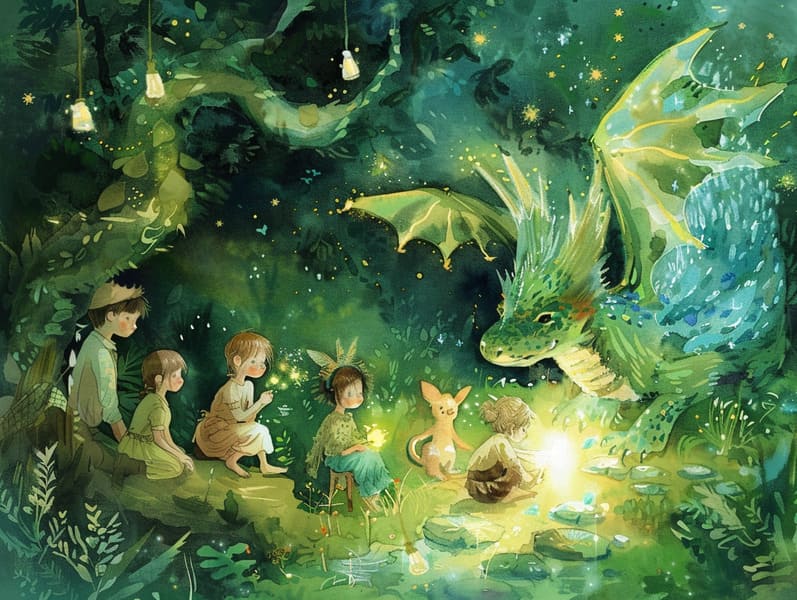
Traditional fairy tales have legendary status. These stories have been recounted from one generation to the next millennia before they were ever documented. They originated from a variety of cultures, including European traditions. They were initially passed along among grown-ups, often carrying themes and messages related to the societal norms and beliefs of the time.
The Brothers Grimm, Jacob and Wilhelm (the Grimm brothers), were among the first to collect many of these beloved fairy tales. Their anthology, "Grimm's Fables," included classics like "The Little Glass Slipper," "Hansel and Gretel," and "Schneewittchen," which have since become classics in the world of children's fairy tales. Similarly, the Danish author's magical fairy tales, such as "The Mermaid's Tale," and "The Story of the Ugly Duckling," have captivated hearts worldwide, solidifying their place in the pantheon of timeless fairy tales.
Despite their age, fairy tales remain as pertinent as ever, especially as children's night stories. These charming stories are now available in different formats, including vividly illustrated books, charming animations, and free fairy tales online.
Their ongoing significance can be connected to several charming aspects:
Ethical Lessons: Traditional fairy tales often share important moral lessons. Narratives like "The Boy Who Cried Wolf" teach the significance of sincerity, while "The Tale of the Tortoise and the Hare" underline the values of perseverance and meekness. These stories offer young readers clear distinctions between moral and immoral, shaping their moral compass in a soft yet impactful way.
Compassion and Insight: Traditional fairy tales frequently depict personalities facing trials and tribulations, stimulating audiences to relate with their struggles and boost their triumphs. For instance, "Beauty and Her Beast" illustrates the virtue of seeing beyond the surface to comprehend the real person of a individual, promoting understanding and recognition.
Cultural Recognition: Many classic fairy tales are rooted in the cultural contexts from which they sprang. Learning from these narratives can provide illuminating insights into different ways of life, encouraging a sense of world respect and understanding.
Fantasy and Imagination: The whimsical elements in timeless fairy tales—fairy godmothers—motivate children’s creative minds. These stories guide readers to enchanted realms, unleashing innovative dreams and a sense of enchantment that lasts a lifetime.
Ancient fairy tales are not only entrancing but also educational. They work as fantastical tools in strengthening various cognitive and affective skills in kids. When old fairy tales are read aloud, they boost speech development by teaching new words and sophisticated sentence structures. This practice also promotes hearing abilities and concentration, as young ones focus on every detail, enthusiastic to see what happens next.
Furthermore, exploring the themes and characters of old fairy tales can strengthen reasoning skills and thinking skills. Kids are shown to find patterns, anticipate outcomes, and get cause and effect. These contemplations also help kids say their thoughts and feelings, strengthening their emotional intelligence.
In today’s information age, the presence of free fairy tales online has made these fairy tales more attainable than ever. Web platforms and digital apps present large libraries of bedtime fairy tales that can be perused or listened via anytime, anywhere. Fairy tales read out loud are particularly favored, featuring an engaging way for the young to engage with these alluring stories. Read-aloud books and read-out-loud stories guide characters and settings to life, often supported by enchanting musical scores and soundtracks that raise the narrative journey.
The timeless fascination of traditional fairy tales lies in their ability to transform to contemporary times while maintaining their central messages. Contemporary versions of these tales often include more representative characters and modern settings, making them accessible to today’s audience. However, the central morals of fortitude, generosity, and justness remain unchanged, continuing to influence audiences of all ages.
Classic fairy tales also offer a sense of solace and knownness. They grant a structured narrative with a distinct beginning, middle, and end, often finishing with the culmination of conflicts and the triumph of goodness over badness. This consistency can be heartening for children, showcasing a sense of stability in an inconstant world.
Old fairy tales continue to mesmerize and teach new generations, maintaining their enchantment and pertinence in modern society. As nighttime stories for kids, they showcase a perfect blend of enchantment and education, sustaining moral values, empathy, and creativity. The presence of online check here fairy tales and the favor of fairy tales recited guarantee that these old tales remain available to new generations.
By holding onto and broadcasting these fairy tales, we continue to recognize the rich tapestry of fantasy and cultural heritage. Whether you are reading a artistically illustrated book, exploring a cyber library, or playing an sound book, the appeal of traditional fairy tales is always within reach. These stories remind us of the endless strength of storytelling and its ability to bind us across time and space.
Even if you are enjoying a vibrantly illustrated book, browsing a web-based library, or listening via an narrated book, the majesty of traditional fairy tales is always within reach.
These tales show us of the unwavering essence of stories and its ability to unite us across generations and cultures, forging a link that delights and instructs alike.